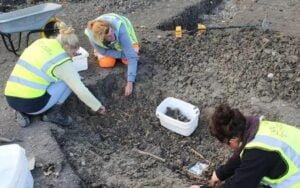The DNA of three late Roman-era skeletons discovered in the same grave has revealed “a family tragedy.”

Experts believe a mother, her unborn son, and her mother-in-law fell ill and died at the same time, BBC News reported.
The grave was discovered in Cheddington, Buckinghamshire, and the DNA was analyzed as part of a project to sequence ancient genomes.
Sharon Clough, a human bones specialist, described the familial relationship as a “very unexpected discovery.” She said: “Obviously, tragedy had befallen this family and this community – and the community wanted to continue the relationship of women in life in death.”
The tomb was discovered during an excavation in 2018 and was deemed “unusual” because most late Roman or early Saxon tombs only contain one body.
The burials took place between CE 255 and 433, according to radiocarbon dating.
Ms Clough added: bone analysis revealed that one of the skeletons was roughly 25 years old when it was buried, while the other was more than 45.
The premature baby was between 32 and 36 weeks old, although it was unclear whether he was still in the womb or had died at the time he was buried.
While she theorized about the two women having a familial relationship, the exact nature of their relationship was revealed only when the bones were sent for analysis.

“The Francis Crick Institute’s Thousand Ancient Genomes of Great Britain research project has been groundbreaking in recent years, answering questions that archaeologists in the past have been able to ask but not answer,” she explaine
Mitochondrial DNA confirmed that the younger woman and infant were mother and child, while “more remarkably,” it was found that the older woman was related to the baby but not the mother.
The project could also tell her that the fetus was a boy, which bone analysis couldn’t.
The bones have been kept at Buckinghamshire County Museum in Aylesbury for future research as techniques evolve.
The excavation was done by the Bristol Society of Merchant Venturers in front of a housing development.
More information: Cotswold Archaeology























